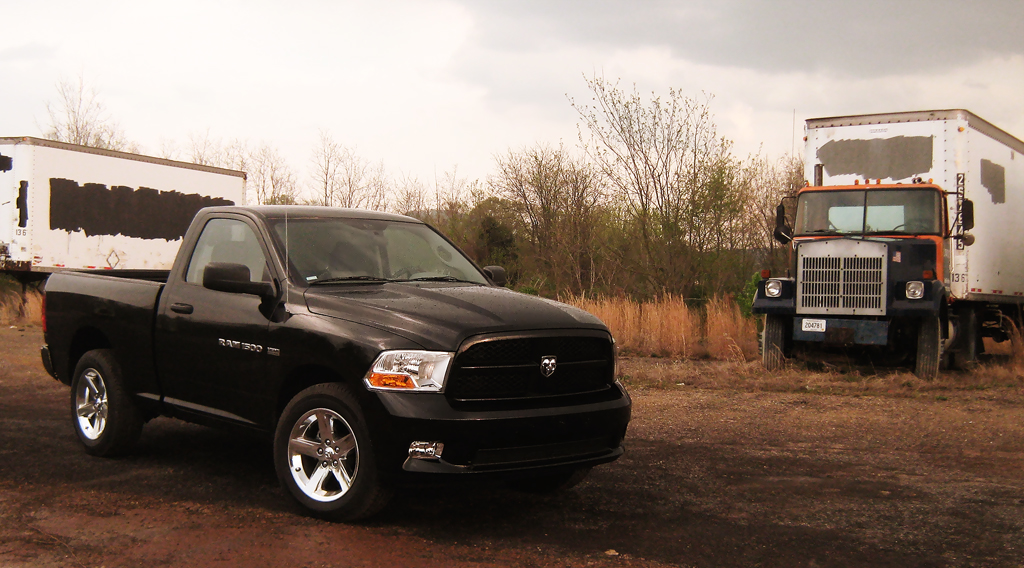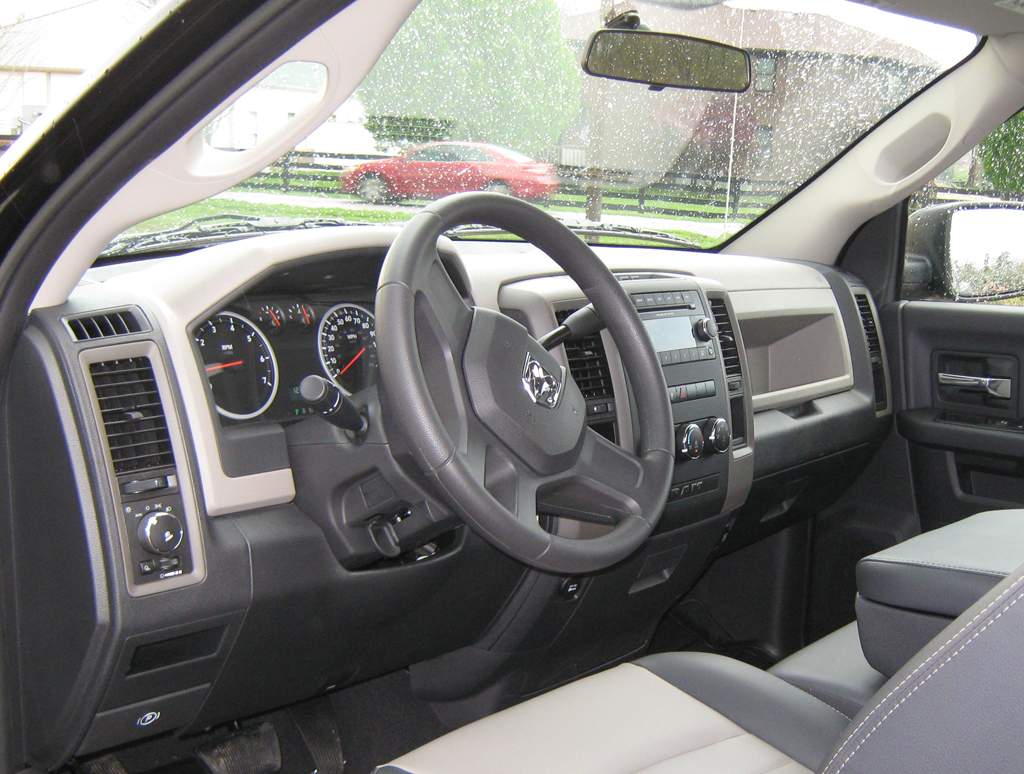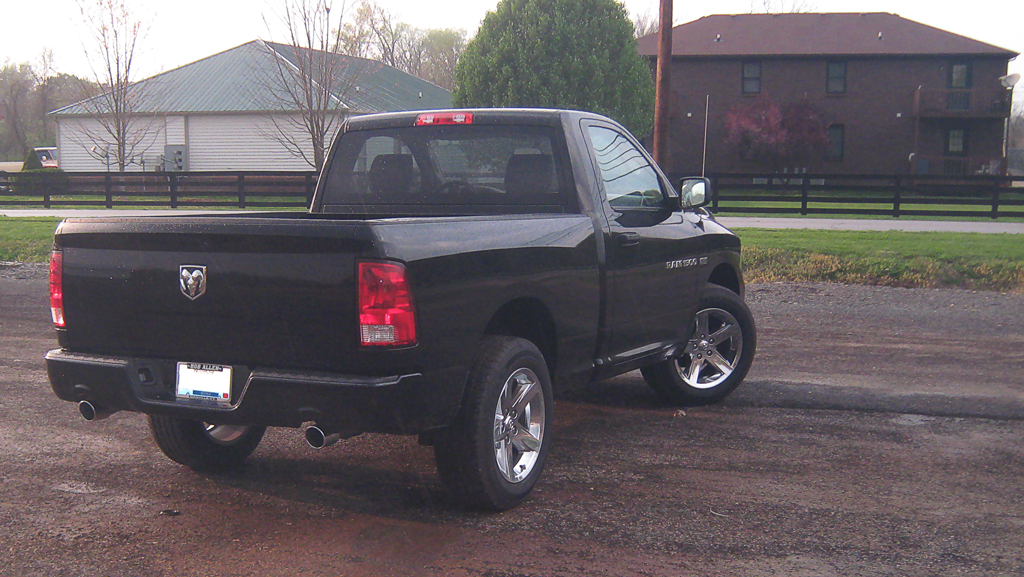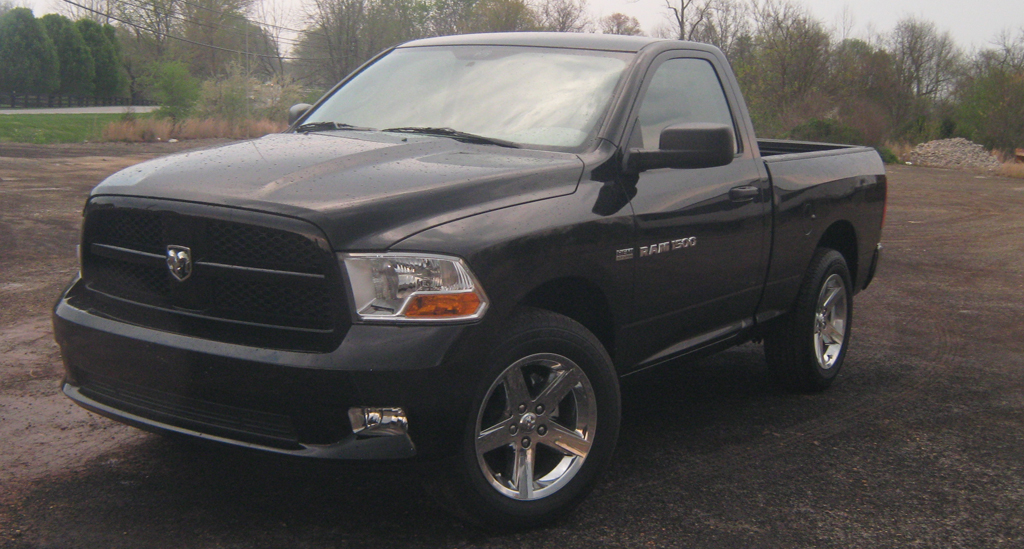G. Noble
Editor/Reporter
CheersandGears.com
April 3rd, 2012
I’ll admit it, right here and right now — I’ve never been the biggest fan ever of pickup trucks. As a work proposition, I know they make a hell of a lot of sense, yes. But as a proposition for daily driving, I’ve always found the experience to be rather cumbersome, partially crude, lazy and inefficient, and subtly vulgar. A truck, for me at least, has always seemed to lack the necessary refinement, communication skills, road manners, and charisma that keeps me behind the wheel of a car. Never mind the tough-and-ready attitude, the commanding seat position, or the lovely experience of a V8 soundtrack that many pickups afford you, in my opinion the only way you could drive something more primitive and harsh on an everyday basis would be to strap yourself to the back of a gorilla.
So, when I took the keys to the jet black, regular cab Ram 1500 Express featured in this review, I expected more of the same. I expected to get behind the wheel of a vehicle as wide as Texas, which rode like a Buick Park Avenue on busted shocks, and would maul me if I didn’t shove enough gasoline down its throat. However, what I found absolutely surprised me.
(Cont. page 2)
At a passing glance, the fourth-generation Ram seems to carry on the typical Dodge truck tradition of packing as much raw visual testosterone as possible under a cut-off sleeve t-shirt. The front fascia still appears as macho as every other Ram since the 1994 redesign with a wide maw of a grille that is, as always, large enough to eat small children whole and a chiseled bumper that’s bigger than Jay Leno’s chin. It also still stands freakishly tall like the last-generation Ram. The truck featured in our review wasn’t even equipped with four-wheel drive and it still managed to eclipse my 6 foot-and-some-odd-inch frame, which made it a little tough for even me to get in and out of.
That’s judging the book by its cover, though. Upon closer inspection things aren’t quite so crass. The new Ram’s exterior is littered with subtle design touches that take the edge off what is otherwise a hulky-looking vehicle. The big-rig look the Ram is famous for is still sort of there, but it’s now far evolved from the caveman worthy brutality of its predecessors. Whereas the second and third-generation Rams so desperately and blatantly wanted to be Kenworth tractor-trailer trucks with their pronounced separate front fenders and huge domed hoods, this new model seems to tone those aspirations down a touch with front body panels that better flow into one another. In fact, the entire design is a rather organic celebration of weight bench-toned shapes and intelligently formed curves.
This new-generation Ram is also one of the more wind-friendly trucks out there. Unlike all pickup trucks of yore which had heavy, massive chromed steel front bumpers that doubled as fuel-sucking battering rams, the new Express has lighter and more aerodynamic body-color plastic bumpers that aren’t much different than what you see on most passenger cars. That toddler-eating front grille is also canted forward at a slight angle to improve the airflow of the truck as it’s barreling down the road. The tailgate also incorporates a wide top edge that spills over to the side and tucks in to form a sort of impromptu ducktail spoiler, once again in the name of aerodynamics. It all makes for a truck that’s more air efficient than any Ram ever built.
Wrapping up the Ram’s standard visual package were a set of 20” chrome-clad rims wrapped in Goodyear Wrangler tires. These rims, which are a standard item on more expensive Sport models, were a $400 option on the Express. Honestly, they’re worth the extra money because, in conjunction with the chrome exhaust tips, they added a classy touch to the Ram’s monochromatic black “creature-of-the-night” appearance.
So, overall it looks … well, pretty good. If the previous Rams were truly the rolling visual embodiment of Chuck Norris as Walker Texas Ranger with spurred cowboy boots and a steer’s head belt buckle, this new one is Christian Bale in an injection-molded Batman costume.It’s still macho and bad ass, just a different sort of macho and bad ass.
(Cont. page 3)
The interior of our 1500 Express test vehicle was as near basic as basic gets in the Ram hierarchy. That’s because the Express models, like the ST and Tradesman trucks, aren’t available with the fancy leather-bound dashboard, country-western themed, laser-etched cow-hide seats, excessive chrome and plood frills, and trick-looking instrumentation that you get in the more expensive trims, like the Laramie Longhorn. The seats here are instead trimmed in vinyl that is by no means terrible considering it is tastefully stitched rather than just thrown on like what you see in other lesser model trucks. But don’t kid yourself; it won’t be fooling anyone if you tried to pass it off as leather. Oh well, at least they’re comfortable.
Since the dashboard isn’t slathered in an animal’s hide, the Ram’s dashboard is a composite of variously colored plastics, which looks maybe a tad too busy. And while the textures are all nice, sorry dash-humping aficionados, none of it is worthy of sleeping in the nude on. That’s okay, though, because this interior was designed for durability and function, not for beauty and form, and hard plastics are common order here. That said, fit and finish was surprisingly good and the only bit of trim that runs the risk of slicing your fingers off is on the exposed side of the expanse of plastic that houses the air-con vents. The switch gear, especially the rotary knobs for the headlamps and HVAC panel — which appear to be derived from the ones GM uses in their trucks — all felt pretty solid and worked fairly smooth.
Missing from the lesser Ram interiors is the nifty two-tier glove box, so in the place of the upper glove box, there’s an ugly, huge empty hole. Curiously, the Ram Express regular cab only can seat a maximum of three people but had a total of 7 cupholders — two in each door and three that folded out of the center instrument panel. Excessive? I think so. Also worth noting is that the trinket bin on top of the center IP still proudly reads “Dodge” so if you were worried that, somehow, Chrysler’s Italian benefactor Fiat was breaking up the company to sell off to the highest bidder fear not. They might be marketing these trucks solely as Rams, but they’re in fact still branded as a Dodge, as obscure of a place as it might be.
As a whole this is the best work-oriented truck interior out there. While the three different shades of gray don’t exactly mesh perfectly, it keeps things from feeling too drab like, say, the laughably depressing “bleed-to-see-color” experience Ford gives you in the basic F-150. The basic Chevrolet Silverado interior, as old as it might be, is the worthy contender here to the experience the Ram affords you and choosing between the two isn’t easy. In the Silverado’s favor, the basic gauge cluster does give you oil pressure and voltmeter gauges unlike the Express and a two-tier glove box is standard. But the Ram feels slightly better polished than the Chevy and it doesn’t suffer from a vast real estate of black plastic stretching from end to end. Cheap hole in the passenger-side dash aside, this interior is almost sort of worthy of a car.
(Cont. page 4.)
Driving this particular generation of Ram is quite unlike driving any other full-sized pickup that’s out there, new or used. Yes, it indeed still feels as wide as Texas just like any other big pickup, but it oddly doesn’t drive like it. It feels nimbler than what its size suggests. The steering feels light — maybe even just a touch too light — and you never find yourself wondering if the tiller is connected to the front wheels. It’s no Lotus Elise of course, and still not an effective tool for carving even small canyons, but it is a decent point-n-go experience and neither you nor the truck will complain if there’s a corner to go around.
Speaking of driving on a twisty road, this is the first truck I’ve driven on one that wasn’t saturated with body roll. The truck feels well planted in most driving situations, even if you try to push things close to the truck’s limits, which are little better than average. This is also the first truck I’ve driven where the chassis didn’t feel like it was molded out of cherry Jell-o over potholes and wrinkled roads. That’s mostly because Ram engineers decided that it was finally time for the large pickup to grow up and get civilized by finally doing away with the time-honored tradition of rear leaf springs. In their place is a multi-link coil spring suspension that isn’t terribly unlike the setup Jeep used on the front of the old compact XJ Cherokee. It’s proven to be rugged but makes the ride and handling characteristics without much fault versus the competition.
It doesn’t come without a price. While the Ram is certainly the most civilized body-on-frame truck on the road, its payload and towing capacities trail behind its rivals. Maximum bed payload for the Express in this road test was just a cocaine-addicted anorexic supermodel over 1500 pounds and the towing capacity rings in at about 9,100 pounds. Those sound like galactic numbers because they are, but Toyota and Ford will both boast to you that their half-ton trucks can tow Saturn and haul the moon in their beds. That maybe true, but for the plethora of buyers who buy trucks these days as daily drivers, a Ram equipped like our test vehicle is more than capable of lugging home whatever you need from Home Depot. Anything more in a half-ton truck is just penis compensation really, and neither the F150 nor especially the Tundra would be as nice to tool around in.
Standard for the Ram Express models is Chrysler’s brilliant 345 cubic-inch, 5.7 liter Hemi V8. This warhorse of an engine generates a huge 390 horsepower and gut-wrenching 407 pound-feet of torque. Those figures can be felt from the seat of your pants as you scoot to 60 mph in around 6.5 seconds. Okay, that’s not the fastest 0 - 60 times in the world, but hey, there are some sports cars out there that lust about being that peppy. Plus, it’s a Hemi and it makes a great noise through its standard 2 inch dual pipes. The six-speed automatic transmission shifts as soft and smooth as Emma Stone bathed in butter, although it can make the engine note sound a bit strange at times on upshifts. The EPA rates the Ram Express at 14 city, 20 highway and with the Hemi’s cylinder deactivation system we observed an average of 17 to 18 mpg. Not bad, but make no mistake, it still drinks more than a college frat boy parked in front of a kegerator.
(Cont. page 5)
So, with the muscle-toned styling, the stripped down interior, the decent ride and handling characteristics, and the performance of the Hemi V8, what Ram has really built here isn’t a pickup truck. It just isn’t as crude as something belonging to that genre, it’s just too charming. Instead, according to the formula described above, what they seem to have built is a big old muscle car only with a big old back porch. So, yes, it’s still a tad vulgar, but judging the truck from that perspective sort of makes it okay. And at around $24,000 dollars before any applicable incentives, there is little else out there that gives you this sort of performance and flexibility of customization for the money, since Chrysler’s Mopar division and a full host of aftermarket companies make a wide variety of parts for these trucks.
God help me, I absolutely adore this big oaf of a machine.
Cheers:
-Styling that's better balanced than previous Rams
-Decent interior
-Good road behavior … for a truck
-Solid performance figures from Hemi V8 power
-Good value for money
Jeers:
-Some interior trim can slice your fingers
-Too many cupholders for so few passengers
-Towing capacities aren't suited for hardcore truck buyers or buyers needing to — ahem! — compensate
-Tall overall height can make entry/exit awkward even for vertically blessed people
-A touch too thirsty
Verdict:
-Ram sets out to build a truck, builds a muscle car instead
Note: Chrysler didn't provide anything for this review.








-3707742431.jpg.06edf8e14f4ccf35c60d4774a543cc11.jpg)



Recommended Comments
Join the conversation
You can post now and register later. If you have an account, sign in now to post with your account.
Note: Your post will require moderator approval before it will be visible.